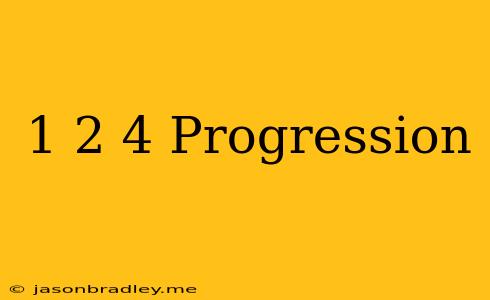The 1-2-4 Progression: A Cornerstone of Jazz Harmony
The 1-2-4 progression is a fundamental chord progression in jazz music, known for its versatility and ability to create a sense of motion and resolution. It's also incredibly common in popular music, with artists across genres utilizing its catchy and adaptable nature.
The Building Blocks: I-ii-IV Chords
The progression consists of three chords:
- I Chord (Tonic): The root chord of the key, providing a sense of stability and home.
- ii Chord (Minor): A minor chord built on the second degree of the scale, creating tension and anticipation.
- IV Chord (Major): A major chord built on the fourth degree of the scale, providing a sense of resolution and movement towards the tonic.
Understanding the Progression
The 1-2-4 progression moves through a series of harmonic relationships:
- I to ii: This movement creates a half-step resolution from the root of the I chord to the third of the ii chord, creating tension and anticipation.
- ii to IV: The ii chord resolves to the IV chord, creating a whole-step resolution from the third of the ii chord to the root of the IV chord. This movement provides a sense of resolution and movement towards the tonic.
The Magic of the Progression
The 1-2-4 progression is so effective due to a number of factors:
- Melodic Motion: The progression encourages strong melodic lines, particularly as the melody often moves from the root of the I chord to the third of the ii chord, and then to the root of the IV chord.
- Emotional Impact: The progression can evoke a variety of emotions, ranging from melancholy and longing to joy and anticipation.
- Versatility: The 1-2-4 progression can be used in various tempos and styles, from slow ballads to upbeat swing tunes.
- Accessibility: The progression is relatively easy to learn and play, making it accessible to musicians of all skill levels.
Examples in Popular Music
The 1-2-4 progression is found in countless popular songs across genres:
- "Yesterday" by The Beatles: A classic example of the 1-2-4 progression in a ballad setting.
- "Fly Me To The Moon" by Frank Sinatra: A jazz standard utilizing the progression in its iconic melody.
- "My Girl" by The Temptations: A soul classic that showcases the progression's versatility.
- "Sweet Home Alabama" by Lynyrd Skynyrd: A rock anthem featuring a memorable 1-2-4 progression.
Beyond the Basics
The 1-2-4 progression can be extended and elaborated upon:
- Seventh Chords: Adding seventh chords to the progression can add complexity and depth.
- Substitutions: Using substitute chords can create variations and interesting harmonic twists.
- Inversions: Inverting the chords can alter the melodic and harmonic landscape.
Conclusion
The 1-2-4 progression remains a powerful and versatile tool for musicians, composers, and songwriters. Its simple structure and harmonic movement continue to inspire creativity and provide a solid foundation for countless musical creations. Whether you're exploring jazz harmony or creating your own original music, understanding the 1-2-4 progression is a valuable asset.
